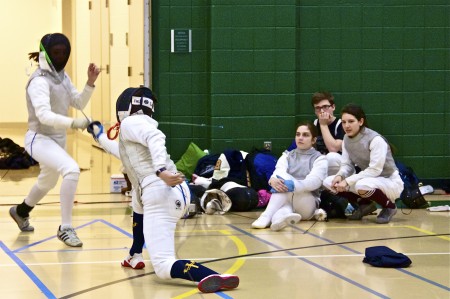Fencing Club Captain Khalfan Javaid was tired as he took his lunch break after three grueling matches.
He and the team were successful in their matches, so far, beating Bryn Mawr College, Drexel University and University of Maryland at Baltimore County, the junior has a lot on his plate as the captain of the team.
Not only does Javaid fence for the club, but he is a stand-in coach, runs the practices four days a week and coordinates the home tournament each spring.
This seems like a lot for just one person to take on and despite the help Javaid gets from his teammates, it is still exhausting to keep up with a program that has little administrative help.
“Fencing is an expensive sport, and we do not have enough funds to provide for necessary things like a coach and non-conference tournament competition,” Javaid said. “We could not even have our tournament in the main gym at the RAC because painter’s tape is not permitted on the courts this time, despite having used it previous tournaments with no problems.
It is frustrating because this limits our chances of giving our club some recognition. No one can simply walk by the gym and watch us; we are secluded upstairs with little fan base.”
Not only is the gym secluded, but it is also much smaller, leaving much less room for the 150 plus fencers and the other personnel involved, including 21 referees. With the constant beeping from the scoring equipment, it was easy to be overwhelmed.
But the players rose above the tough atmosphere and lack of support and came out on top.
They are second in the southern part of the conference and sixth overall.
In the tournament in the fall, they only lost one match to the high-ranking United States Naval Academy.
Since the team went undefeated on Feb. 23, they will finish second place in the conference, an amazing feat for a team with no coach and little funding, unlike other teams like Navy who have top-tier coaches and give out scholarships to students.
The planning for the tournament was difficult. Each team had to contribute
$200, bring their own scoring equipment and Khalfan and the members had to plan months in advance, hiring referees and securing gym space at the RAC.
Fortunately, the fencing community prides itself on its friendly competition and camaraderie among the teams.
There is little animosity and the players mix easily, discussing fencing techniques, sharing knowledge and discussing other tournaments going on throughout the nation.
Perhaps the camaraderie is due to fenc- ing’s lack of recognition among main- stream sports, and they must depend on each other for support. But the team still looks to the wider community in hopes for support and recognition for the sport they love so deeply.
“We have had a difficult time fund- raising due to the lack of recognition of fencing among the school,” Khalfan said, “Most people do not even know there is a fencing club on campus, but we hope, with better recognition, the administration will provide more funding and we will then be able to become a better team”.







Comments